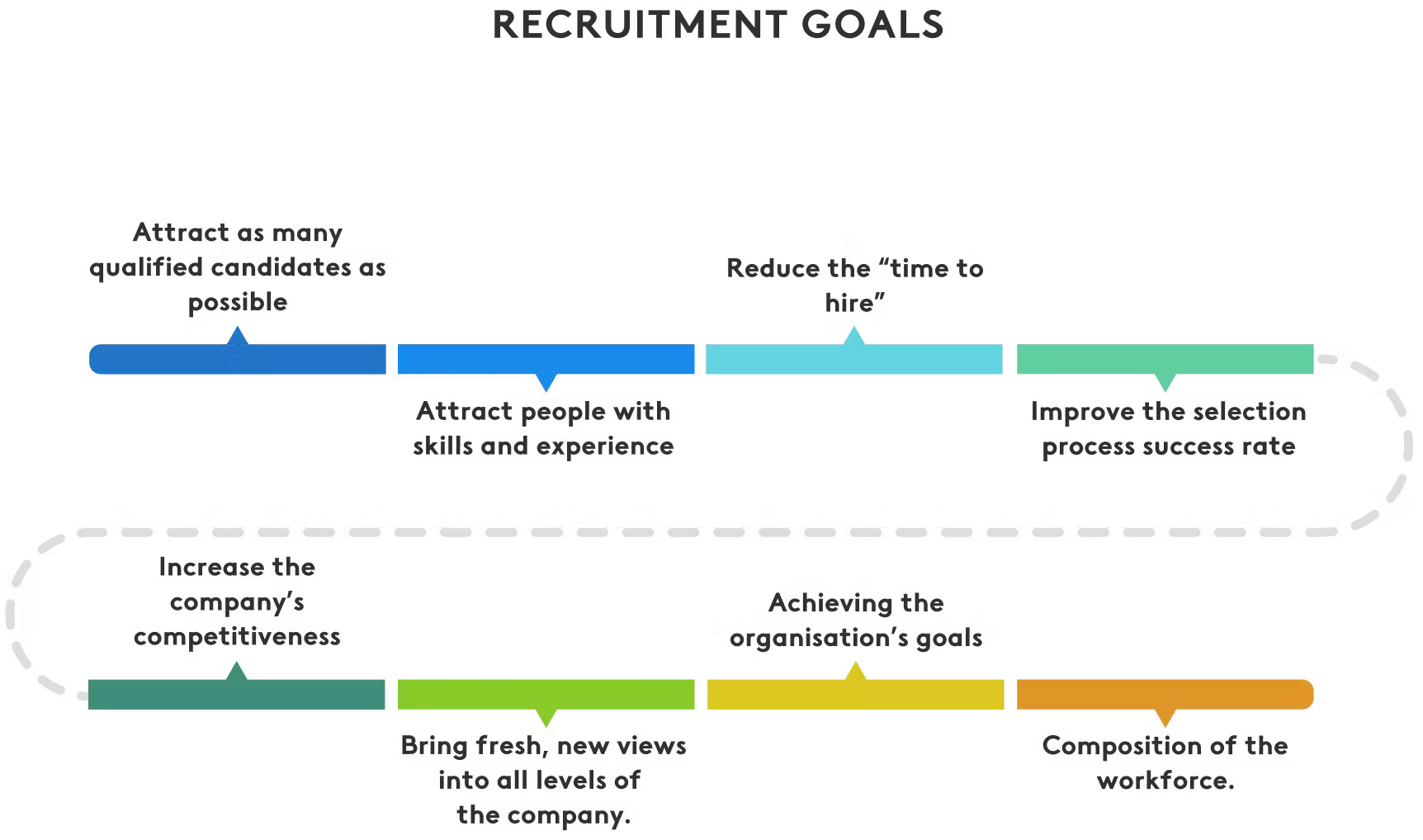Recruitment is a crucial process for any organization, as it involves attracting, selecting, and hiring the right candidates to fill vacant positions. The success of a company largely depends on the quality of its workforce, making the recruitment process a vital aspect of organizational growth and development. In this blog post, we will explore the various stages involved in the recruitment process and discuss the importance of each step.
Stage 1: Identifying Staffing Needs
The process of recruitment is a crucial aspect of identifying staffing needs within an organization. Stage 1, known as “Identifying Staffing Needs,” sets the foundation for a successful recruitment strategy. Here are some key points to consider:
Assessing current workforce
Before initiating the recruitment process, it is essential to evaluate the existing workforce. This assessment involves analyzing the skills, experience, and qualifications of employees to identify any gaps or areas requiring additional resources.
Defining job roles
Clearly defining the job roles and responsibilities is vital in this stage. By precisely outlining the requirements and expectations for each position, organizations can effectively identify the necessary skills and qualifications for potential candidates.
Analyzing future needs
Anticipating future organizational needs is crucial in identifying staffing needs. Organizations must assess factors such as projected growth, upcoming projects, or changes in business strategies to determine the number and type of positions required to meet those objectives.
Collaborating with department heads
Effective communication and collaboration with department heads are essential during this stage. By involving them in the process, organizations can gain insights into specific departmental requirements and align staffing needs with their objectives.
Conducting gap analysis
A gap analysis is performed to identify the discrepancies between the current workforce and the desired staffing levels. This analysis helps organizations understand where they lack resources and enables them to develop strategies to bridge those gaps.
Considering budget constraints
Budget considerations play a significant role in identifying staffing needs. Organizations must evaluate their financial resources and constraints to determine the feasibility of recruiting new employees or reallocating existing staff.
Reviewing industry trends
Staying abreast of industry trends is crucial in identifying staffing needs. By understanding emerging technologies, market demands, and industry shifts, organizations can identify the skills and expertise required to stay competitive.
Leveraging technology
Utilizing recruitment software and technology can streamline the identification of staffing needs. These tools can help automate processes, track candidate data, and analyze workforce metrics, providing valuable insights for decision-making.
By following a systematic approach during Stage 1: Identifying Staffing Needs, organizations can lay a strong foundation for successful recruitment and ensure they have the right people in the right roles to achieve their business objectives.
Stage 2: Sourcing Candidates
Sourcing candidates is a critical stage in the recruitment process, as it involves identifying and attracting potential candidates who possess the desired skills and qualifications for a given position. This stage aims to build a pool of qualified individuals from which the hiring team can select the most suitable candidates to move forward in the hiring process.
The first step in sourcing candidates is to define the specific requirements and qualifications for the position. This includes understanding the job description, responsibilities, and necessary skills. With this information in hand, recruiters can then create a targeted approach to find candidates who meet these criteria.
One of the most common methods of sourcing candidates is through online platforms and job boards. Recruiters can post job advertisements on various websites and platforms that are relevant to the industry or position they are hiring for. These platforms allow candidates to search for job opportunities and submit their resumes, making it easier for recruiters to review and shortlist potential candidates.
Using Professional Networks to Tap Talent
In addition to online platforms, recruiters also utilize their professional networks to source candidates. This involves reaching out to colleagues, industry connections, and even current employees for referrals. Employee referral programs are often implemented to encourage employees to recommend qualified candidates, as they can provide valuable insights into the individual’s skills and cultural fit within the organization.
Another method of candidate sourcing is through direct sourcing or headhunting. This approach involves proactively searching for potential candidates who may not be actively seeking new opportunities. Recruiters may use various tools and techniques, such as social media platforms, professional networking sites, and databases, to identify and engage with these passive candidates.
Once potential candidates have been identified, recruiters then evaluate their qualifications and suitability for the position. This may involve conducting initial screenings, reviewing resumes and cover letters, and assessing their skills and experience through interviews or assessments.
Stage 3: Screening and Shortlisting
The process of recruitment involves various stages, one of which is screening and shortlisting. This crucial step plays a significant role in identifying potential candidates for a job position. Screening refers to the initial evaluation of applicants’ resumes, cover letters, and application forms. It helps in filtering out candidates who do not meet the minimum requirements or possess the necessary qualifications.
During the screening process, recruiters typically look for key information such as education, work experience, skills, and relevant certifications. They also assess factors like job stability, career progression, and any notable achievements. By carefully reviewing these documents, recruiters can determine if an applicant meets the basic criteria for the job.
After the initial screening, the shortlisting phase comes into play. This stage involves selecting a smaller pool of candidates who best match the job requirements. Recruiters evaluate the screened applicants more thoroughly by conducting interviews, assessments, or tests. Shortlisting allows employers to delve deeper into a candidate’s qualifications, experience, and compatibility with the company culture.
The screening and shortlisting process is essential for narrowing down the candidate pool and identifying the most suitable individuals for further evaluation. It helps save time and resources by focusing on only the most promising applicants. Effective screening and shortlisting increase the chances of finding the right candidate who will contribute to the success of the organization.
Stage 4: Interviewing
Stage 4: Interviewing is a critical phase in the hiring process, where employers have the opportunity to assess candidates’ qualifications, skills, and suitability for a specific role. During this stage, the keyword “interviewing” plays a significant role in determining the success of both the candidate and the hiring company.
Interviewing involves a series of structured conversations between the employer and the candidate, where questions are asked to evaluate the candidate’s knowledge, experience, problem-solving abilities, and cultural fit within the organization. The keyword “interviewing” represents the process of evaluating candidates through face-to-face or virtual meetings.
Employers use various interviewing techniques such as behavioral, situational, and panel interviews to gather relevant information about a candidate’s past behavior. Also this will help them analyze decision-making skills, and ability to handle real-life work scenarios. The keyword “interviewing” helps employers identify the most suitable candidate who can fulfill the job requirements and contribute positively to the organization.
Candidates also play a crucial role during the interviewing stage by showcasing their qualifications, experiences, and interpersonal skills. They use the keyword “interviewing” to demonstrate their ability to communicate effectively, think critically, and provide thoughtful responses to interview questions.
Stage 5: Evaluation and Selection
Recruitment is a crucial process for any organization to find and attract the right talent. Stage 5 of the recruitment process, known as Evaluation and Selection, plays a vital role in ensuring that the most suitable candidates are chosen for the job.
During this stage, recruiters thoroughly evaluate and assess the applicants based on various criteria. They carefully review resumes, application forms, and cover letters to screen candidates who meet the essential qualifications and experience required for the position. This initial screening helps narrow down the applicant pool to a more manageable number.
Next, the selected candidates are usually invited for interviews, which may be conducted in person, over the phone, or through video conferencing. Interviews provide an opportunity for recruiters to further evaluate candidates’ skills, knowledge, and suitability for the role. They may also include behavioral or situational questions to assess how candidates might handle specific scenarios.
Apart from interviews, recruiters may also use other selection tools such as assessments, tests, or simulations. It is to gauge candidates’ abilities and competencies related to the job. These additional evaluations help in making a more informed decision.
Finally, after all evaluations are completed, recruiters collaborate with hiring managers or decision-makers to select the best candidate for the position. Factors such as qualifications, experience, cultural fit, and potential for growth within the organization are taken into consideration during the final selection process.
Stage 6: Job Offer and Onboarding
After selecting the ideal candidate, a formal job offer is extended. This offer includes details such as salary, benefits, start date, and any other relevant information. Once the candidate accepts the offer, the onboarding process begins. Onboarding involves integrating the new employee into the organization. You should be providing necessary training and orientation, and ensuring a smooth transition into their new role.
Recruitment Process in Non IT Industry
Recruitment process listed above can be adopted to any Industries. For traditional industry such as Jewelry, Precious Metals, Gemstones or Retail, many Hiring Managers follow the same process. Technology adoption is low in these industries. But, with rapid adoption of platforms, job boards, marketplaces and software automation tools, this hiring process is getting mature.
From candidate perspective, preparing interviews, getting to know the commonly asked interview questions is also important. This guide is also equally important for potential candidates to understand how recruitment works.
Conclusion
The recruitment process is a multifaceted and critical aspect of organizational success. You can start by identifying staffing needs, sourcing candidates effectively, screening and shortlisting applicants, conducting interviews and evaluating candidates. You can finally extend a job offer and facilitate onboarding process. By doing this, organizations can attract and retain top talent. A well-executed recruitment process not only ensures that the right individuals are hired in this way. But also contributes to a positive work environment and overall organizational growth.
Remember, an effective recruitment process is an investment in an organization’s future. As hiring manager prioritizing each stage and continuously improving recruitment strategies is important. Companies can build a strong and talented workforce capable of driving success in today’s competitive business landscape.







